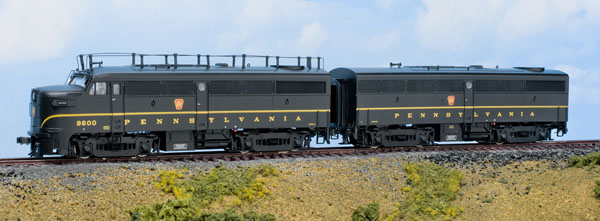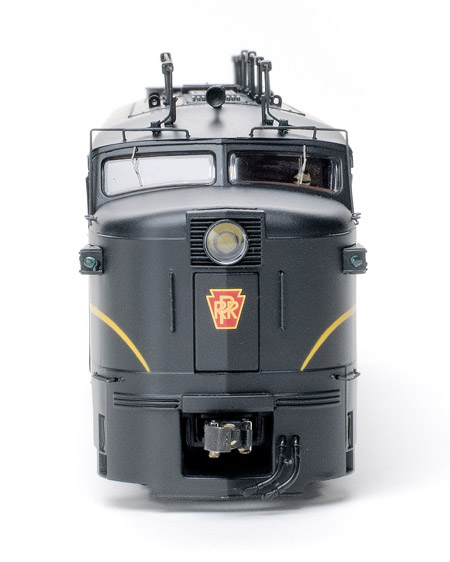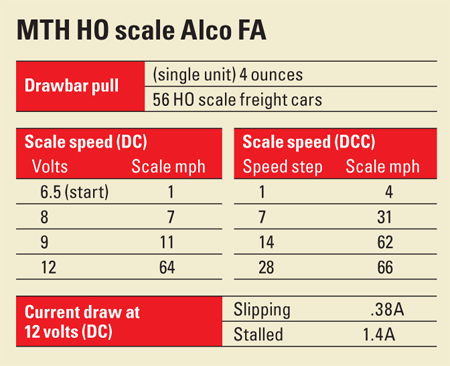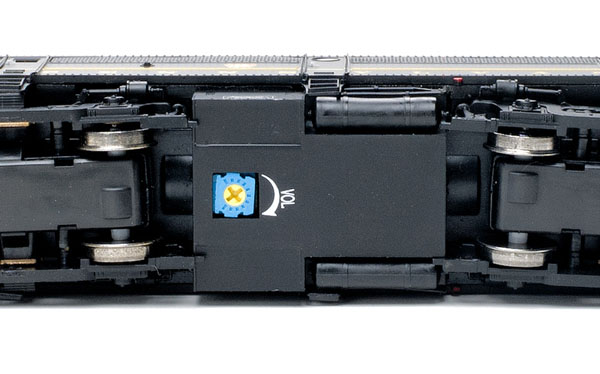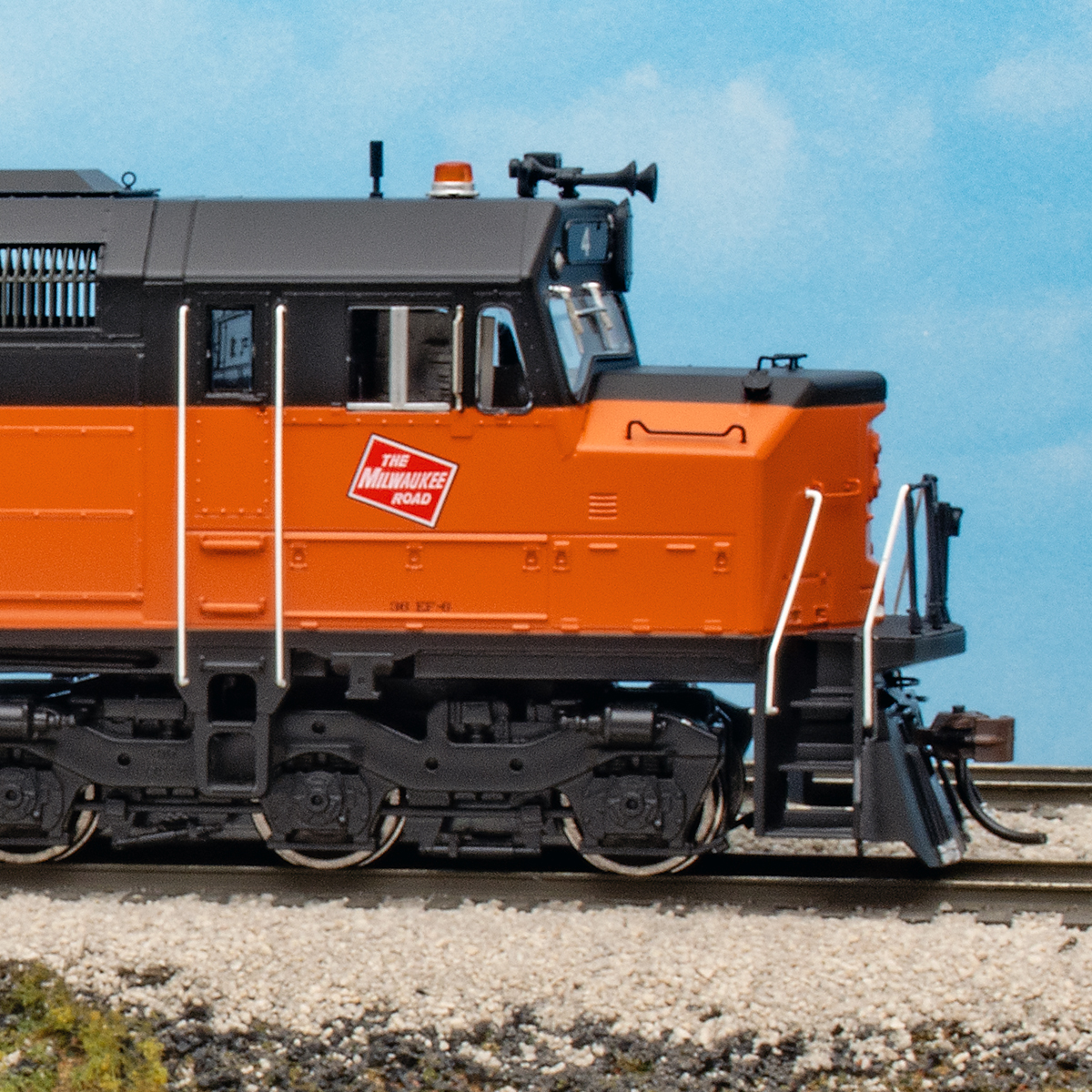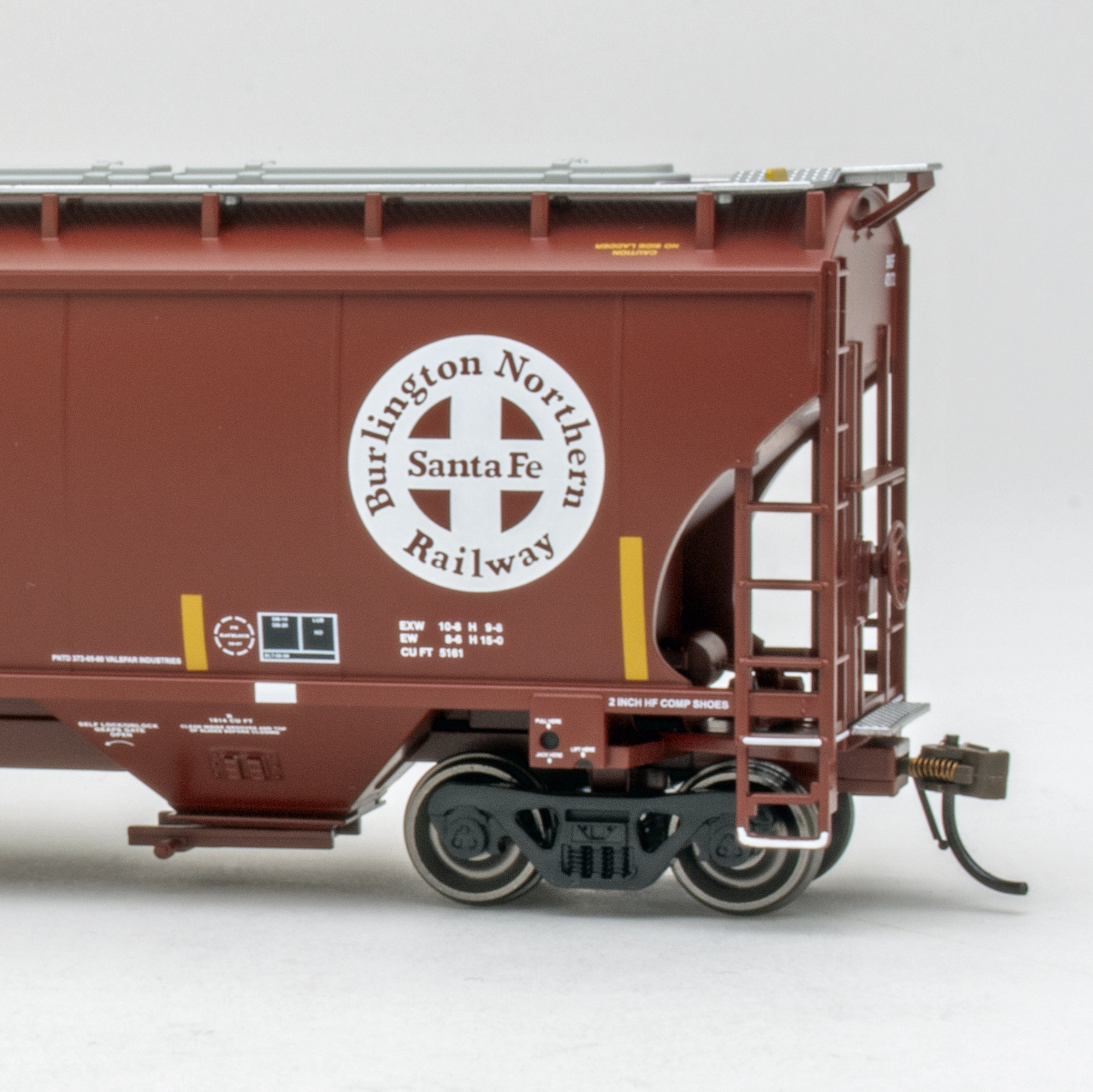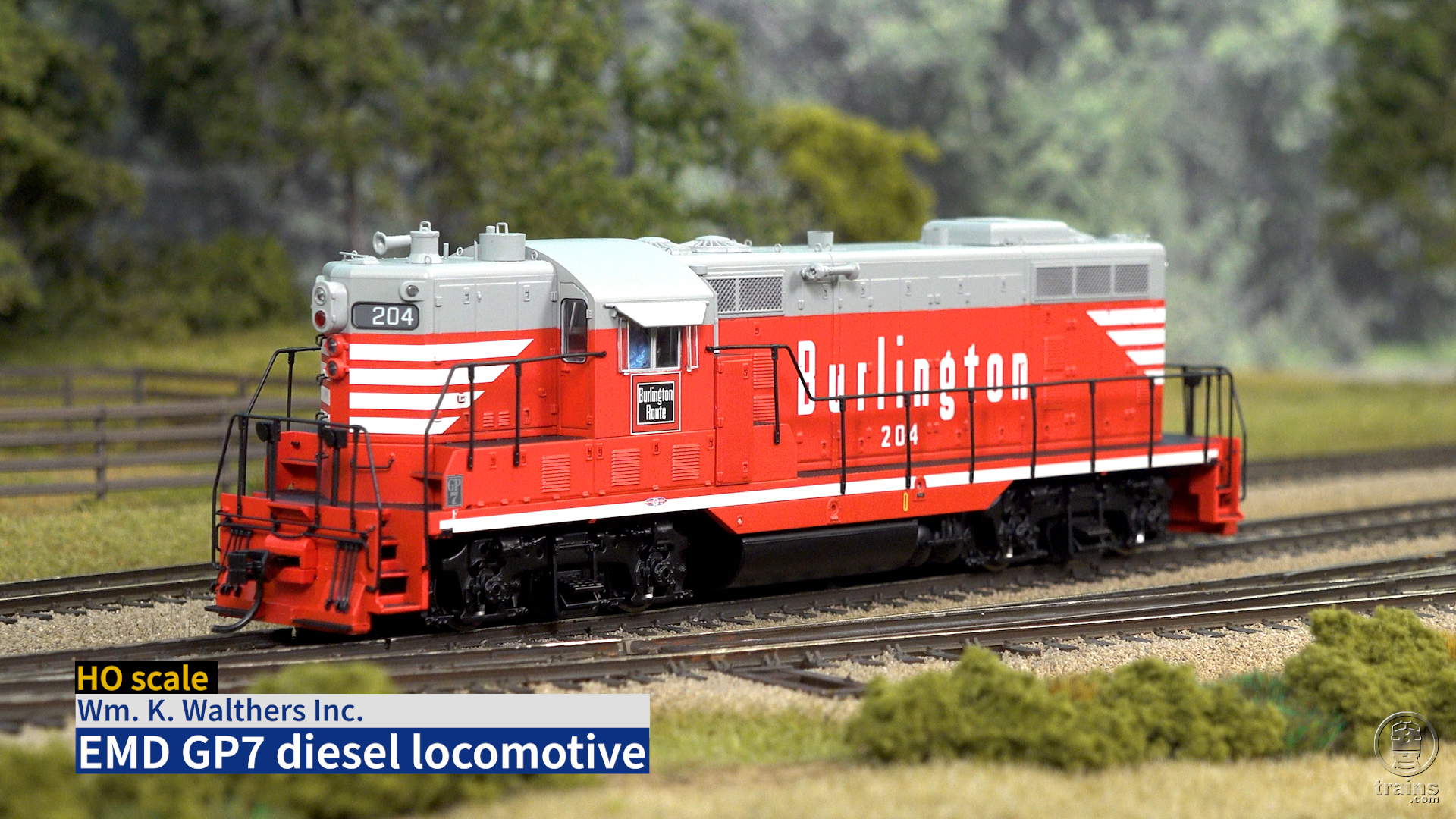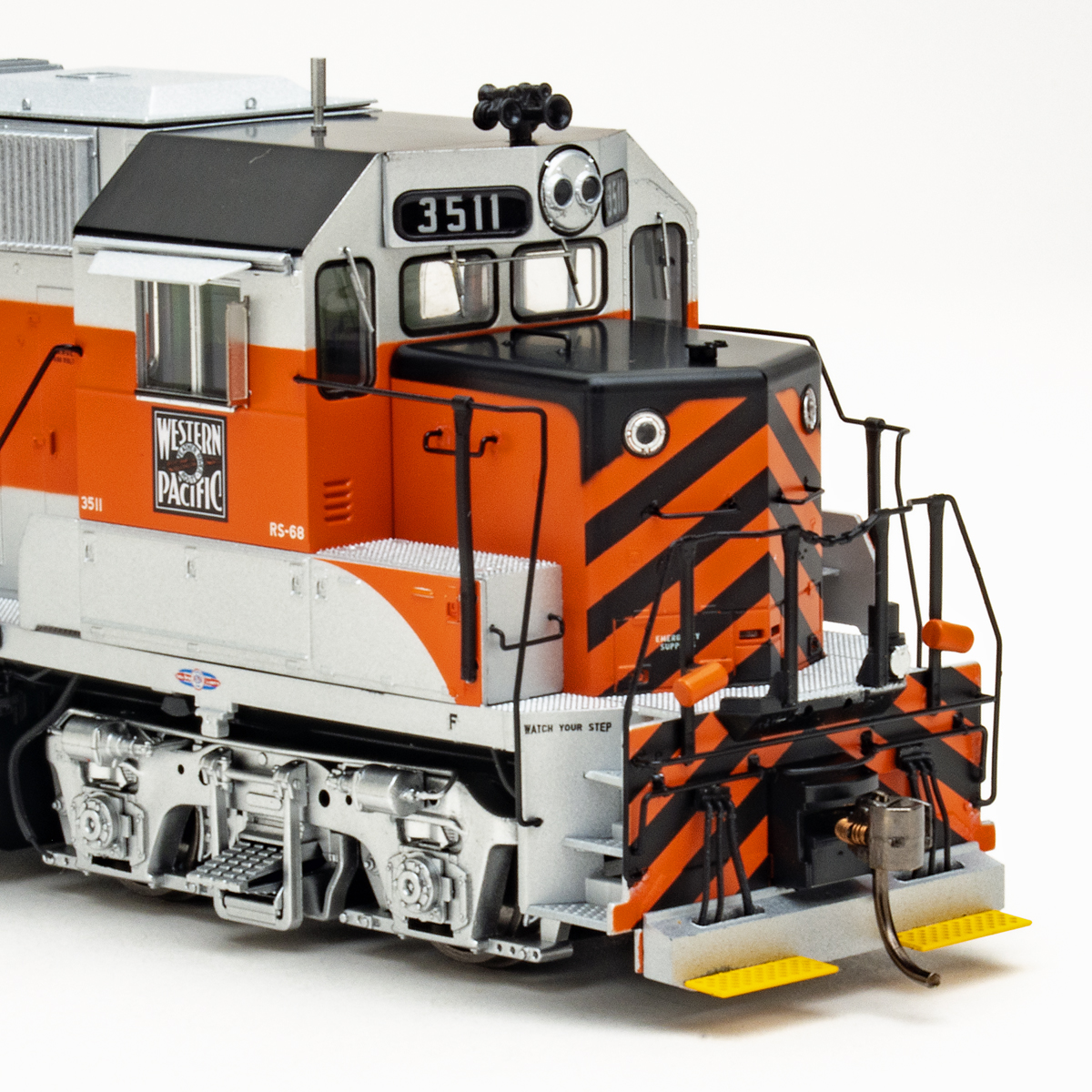The prototype. Equipped with Alco’s 1,600-hp V-12 244 motor, the FA-1 and FB-1 were rushed to market to compete with Electro-Motive Division’s FT. As such, the Alcos suffered from reliability problems, but still sold well. Almost 450 of the FA-1 were built starting in 1945, along with nearly 250 of the cabless FB boosters. Union Pacific bought 46 FA-1s and 44 B units, the largest combined
total (the Gulf, Mobile & Ohio had more A units than UP, but fewer Bs). The other five roads offered by MTH owned 10 or fewer of each kind of unit.
The engines represented by MTH’s model are late production units, as evidenced by their higher nose-mounted headlight boxes and the lack of a curved trim piece over the grill behind the cab. They also have centered, horizontal stacks, indicating a motor that’s been fitted with a water-cooled turbocharger. This too was a later feature, adopted to address problems with the locomotive’s initial air-cooled turbochargers.
Despite their mechanical problems, many FA-1s soldiered on for decades, with several locomotives still in service today on excursion railroads.
Our sample models were decorated for the Pennsylvania RR, in the road’s single-stripe scheme. The paint, in PRR’s Dark Locomotive Green Enamel (known to modelers as Brunswick Green), was applied smoothly and evenly. There were no voids or gaps in the yellow stripe or lettering, and the smallest lettering was legible under magnification.
The locomotives are loaded with etched-metal and wire details. The radiator fan grill is finely etched, as are the side grills. The plastic windshield wipers and the handrails are close to scale thickness. I was impressed that the door handles, simply molded in place on most models, here were separately applied
detail parts.
Some models have roadname-specific details, such as the trainphone antennae on our Pennsylvania RR sample (the handrail-like structures on the roof of the A unit). One antenna on ours had a bit of a wave to it, but the ones on the prototype often weren’t straight, either.
I inserted four flat jewelers’ screwdrivers into slots on the locomotive’s bottom edges to free the shell from the body. Underneath, practically every space not filled with working components is filled with cast-metal weights. The decoder is sandwiched between the motor and yet another weight. There are painted engineer and fireman figures in the minimally detailed cab. The speaker is in the back, below the radiator fan, pointing downward.
Our test models came equipped with MTH’s proprietary Digital Command System (DCS) and Proto-Sound 3.0 sound system in both units, so I tested both units under direct current, Digital Command Control, and with an MTH DCS Commander. The performance chart on the next page shows the testing results for a single unit.
I tested the model in DC with a Model Rectifier Corp. Tech 4 power pack, which delivers a maximum of 14 volts to the track. Our standard speed test goes up to 12 volts. The DCS-equipped FA can handle up to 24 volts.
Like other sound-equipped models, the MTH FA required a lot of voltage to get started. Our sample displayed great sensitivity in the lower end of the speed curve. It started moving at 6.5V, just a shade higher than where the sounds kicked in. At this voltage it rolled at a steady 1 scale mph and accelerated to 11 scale mph at 9V.
The speed curve sharpened between 9V and 12V. At 12V, the model reached 64 mph, a prototypical speed for a freight hauler. At the power pack’s 14V maximum, the model ran at 97 scale mph. The prototype could be geared to attain 92 mph.
The model’s performance was smooth under Digital Command Control. It rolled steadily at 4 scale mph at speed step 1. It reached close to its peak speed at speed step 14, halfway through our NCE PowerCab’s 28-step speed scale. For finer speed control I used the DCC system to set the decoder to 128 speed steps. The decoder also comes programmed with a number of speed curves, selectable through Configuration Variable (CV) 25, which allows the user to customize the performance appropriate for the layout.
Other CVs allow you to change the long and short address and adjust the starting and maximum voltages. The models support CV19 for advance consisting. I advance consisted the A and B unit, and used CVs 21 and 22 to adjust the supported functions of each unit. That way, only the front remote-opening coupler of the FA would trigger when I pressed F7 and only the rear coupler of the FB would trigger when I pressed F8.
I programmed both locomotives on the main. The MTH models can function on programming track. For most DCC systems, this requires a programming track booster.
Operating the locomotives under MTH’s proprietary DCS was simple. The DCS Commander console (sold separately) has buttons for practically all the locomotives’ commonly used functions. Advanced functions such as momentum can also be programmed via the controller. And rather than displaying voltage or speed steps, the controller’s digital display shows the locomotive’s speed in scale miles per hour. I tested this feature with our workbench’s speedometer and found it quite accurate. Turning the controller’s thumb wheel to 1 mph produced a steady 1 scale mph roll.
Just as notable, though, is their pulling power. Each unit weighs in at about 1.25 pounds. With all wheels powered, this results in impressive traction. The A unit by itself mustered a quarter-pound of pull, according to our test bench’s digital force meter. When coupled together, the A-B pair exerted enough force to pull 120 standard HO scale freight cars on straight and level track.
As previously noted, both locomotives come equipped front and back with remote-opening couplers. Slightly larger than a Kadee no. 5 knuckle coupler, these couplers open (with an appropriate sound effect) with a command from the DCC or DCS controller. The A and B units also include user-installed Kadee-compatible magnetic knuckle couplers.
A freight icon. Alco’s FA-1 and FB-1 gained fans for a handsome design. These well-detailed and powerful MTH models will cut an equally dashing figure on any HO scale transition-era layout.
Manufacturer
MTH Electric Trains
7020 Columbia Gateway Dr.
Columbia, MD 21046
mthtrains.com
Road names: Pennsylvania, Baltimore & Ohio, Great Northern, Lehigh Valley, Reading Co., Union Pacific
Era: 1945 to 1970s
Features
- All-wheel drive and electrical pickup
- Directional headlights
- Digital Command System and Proto-Sound 3.0 sound system
- Etched-metal and wire details
- Five-pole, skew-wound can motor with flywheels
- Internal circuit breaker for stalled motor protection
- Painted crew figures in cab unit
- Remote-control couplers mounted at the correct height (user-installed Kadee-compatible magnetic knuckle couplers provided)
- Sprung diaphragms
- Weight: FA-1, 1 pound 3 ounces; FB-1, 1 pound 4 ounces





